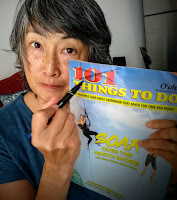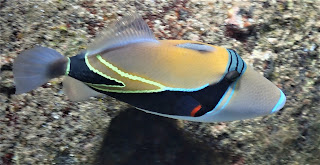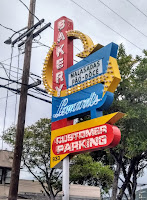Hawaii, USA
 |
| Diamondhead in green |
Already
chronicled in the blog are the 14 days we spent in quarantine after escaping
Indonesia and arriving in Waikiki.
Our original Plan, which by then was
somewhere much further along the alphabet, well past B, was to spend a month in
Hawaii and see how virus containment was going both in the US and in Mexico.
Many years ago, Mark worked in Hawaii, so it was a familiar
 |
| ....2 months later! |
base, as well as
English-speaking, well … Pidgin-speaking anyway. “ey, brah! Howzit?”
We
negotiated our rent down for the second half of April and settled in, more or
less, to the new reality of a mostly isolated lifestyle. Beaches were closed
except for walking to and from the ocean to surf (which we don’t). Our pool was
closed. Heck, we couldn’t even play pickleball! (which we don’t). What we could
do was walk, so we donned masks and ventured out most days for a couple miles
of strolling, sometimes along the Waikiki beachfront, sometimes through a
nearly abandoned Waikiki. All the high-end shops were boarded up, with only a
few ABC stores open, as well as some restaurants valiantly trying to do
curbside pickup.
In
the days just prior to our arrival, Hawaii had 30,000 visitors (tourists,
military, aircraft crew) arriving each day. The day we arrived, that number was
less than 1000. Linda had to wake up the guard at the airport to ask where to
find a taxi! We ended up calling an Uber, no taxis.
The
almost total absence of tourists revealed a large number of homeless people.
They no longer blended in with crowded streets, not that they ever did,
perhaps, but they were much more conspicuous.
 |
| hellooooooo |
We don’t know whether their
presence there was “normal”, or whether they had relocated to the Waikiki area
since there were no people. Likely the former since the Honolulu PD was in
evidence everywhere. It seemed like HPD cruisers were parked all over the area,
with their bright blue lights on, often without anyone apparently inside. We
saw a number of police responses to individuals screaming on street corners,
usually at least 3 cars and 6 officers. This was a very clear example that
police are asked to do more than they are trained to do.
[Sidebar: It turns out that in 2013 the Hawaii legislature approved $100,000 for a pilot program to send homeless back to their families on the mainland. It also turns out that until early in 2020, Hawaii had the highest per capita homeless rate in the US. New York overtook the top spot recently. Estimates are that 1/3 to more than half of Hawaii’s homeless population are not from Hawaii. The current “repatriation” program is funded mutually by taxpayer dollars and matching funds from the HTLA, Hawaii’s Tourism and Lodging Association.]
 |
| Nope |
Though
there are much worse places to shelter in place, Hawaii was / is at this time
not the “land of sun and fun” most associate with this vacation destination.
Nothing was open except for grocery stores and some restaurants. EVEN a number
of the ubiquitous ABC Stores were closed – with signage pointing one to the
next open location, at which everything was 10% off!
 So we went for walks,
and rented a car once in a while just to drive around the island a bit. Punchbowl Cemetery is always an amazing sight.
So we went for walks,
and rented a car once in a while just to drive around the island a bit. Punchbowl Cemetery is always an amazing sight.
About a
month in, when we heard we could go hiking, we drove to the head of the
lighthouse trail only to find hundreds of people parked and walking around,
many without masks. Nope. So we drove around to Kailua and walked on the beach
a bit, with plenty of distance.
Medical
Visits in the Time of Covid
Linda
had a few medical experiences while we were there, which were interesting. She
was about out of contact lenses, so made an appointment at the Costco for an
eye exam, since they would not accept her Mexican prescription (no brand name?
horrors!). They were being very careful, only 1 abbreviated appointment per
hour, masked with much cleaning and sanitizer. She then ordered the lenses by
phone, which came in about a week.
The
optometrist, upon hearing that Linda had not had a glaucoma exam in a while and
had a lot of family history, suggested an office in Honolulu. That appointment
involved a lot of waiting down the hallway, as the waiting room was blocked to
only accommodate about 4 people.
THEN
a crown popped off while Linda was ACTUALLY FLOSSING. Our property managers
suggested a nearby dentist, who had been open continuously. They were very
professional – 2 people in the waiting area (Mark sat outside with the
chickens), taking your temperature, giving you sanitizer, rinsing your mouth
for 1 full minute with mouthwash. Ick.
Dentists, of course, have been wearing PPE since HIV times, but now they
don’t have that ceiling spotlight to aim at you, just a headlamp to blind you
more closely! It turned out to be on onlay not a crown, which involves a
chemical bonding procedure instead of super glue.
As
we are now uninsured in the USA, all payments were in cash. Ouch. Let’s just
say the prices in the US are multiples of the price in Mexico.
Grindz
(comfort food)
 |
| We all scream for POKE!! |
A
key high point of being in Honolulu was the FOOD.
It
suddenly occurred to us that we could buy FRITOS. And CARAMACS. Spam musubi,
kalbi ribs, poke on every corner, kim chee, mac salad. Yes, these are makeable
at home, but something about authentic Hawaiian just tastes better.
And
Leonard’s Malasadas was just up the road!! Malasadas are Portuguese donuts
about baseball size, made fresh to order and rolled in sugar (regular, cinnamon
or tart li hing mui). Heavenly puffs of
warm fried dough that carry you away on a cloud of bliss. Mmmmmm. Mark almost
applied for a job, they were hiring!
A
highlight was ordering anniversary dinner take out from Alan Wong’s restaurant,
a high-end Hawaiian-centric flagship that we had eaten at several times before.
Menu published online, call in order, pay with credit card, set a pick up time.
Then we pulled up, popped the back and 4 staff (we ordered that
much) put all the food in the back. We had left a tip there for them, and they
seemed pleasantly surprised. They kindly gave us free mudslide cookies for our
anniversary, which Linda is vowing to attempt to replicate, they were so
chocolatey but light!
We
basically ordered enough food for about a week, what with the 2 entrees which
included salad and dessert, ramen kit, poke (raw fish salad) kit, 2 bottles of
wine. What a treat. Linda is still sighing remembering it.
The
“ramen kit” bears more description. It was actually a steal for $24, something
like 6 meals’ worth, 2 containers of broth, delicious fresh noodles, tasty
local-made kamaboko, ranch eggs, green onion, parmesan cheese!?, and duck meat.
Another
fun meal was the fried rice, fried garlic chicken and pork chops (yes, fried!)
from Side Street Inn on Da Strip, which had long been on Linda’s list.
 |
| Sourdough starter bubbling away |
And
yes, of course, Linda made a run at making sourdough … she named it Moana. (You're welcome!) The
biscuits were good, the bread a bit dense. Not a rousing success, but good
enough that she dried out the starter, and brought it back to Mexico for fun.
Not sure if there will be a rechristening and name change.
Diving
 |
| Blue-lined snapper |
 |
| A humuhumunukunukuapua'a (really! the state fish) |
After
the quarantine, we checked in with a divemaster we had taken a nitrox course
from in 2011. He was still around, and was looking to restart dive trips with
locals only when the government allowed. We went out, eventually, on a boat with
one other diver, then a few weeks later with 3 other divers. The boat actually had
been used in a few Hawaii Five-O (the new one) episodes. The diving was
interesting, apparently in part due to no one diving for a few months. The turtles seemed happy to see us! We also
did a couple of shore dives, and saw a lot of interesting critters, including
big fish, and 2 sets of mating octopuses. Our previous Hawaii diving had been
mostly meh, so this was a pleasant surprise.
 |
| a BIG frogfish |
Opening
up
 |
| Hard to pass up an Irish pub |
Near
the end of our three months there, some retail was opening up, like malls, some
shops, bars. We admit that when we noticed the Irish Pub near us was open, we
walked past, then Mark wondered if we would invoke some kind of Gaelic curse if
we DIDN’T go in. We went in. So we ordered one drink, then left. It felt a little
odd.
 Then
the Zoo opened, which was only a couple of blocks away. The sign inside said “Best
Zoo for 2300 miles” – which Mark thought about summed it up. It was
interesting, though, and we learned a new word – zoonotic! We were told to put
the masks on so we wouldn’t contaminate the animals. Which is a perfect cycle.
Then
the Zoo opened, which was only a couple of blocks away. The sign inside said “Best
Zoo for 2300 miles” – which Mark thought about summed it up. It was
interesting, though, and we learned a new word – zoonotic! We were told to put
the masks on so we wouldn’t contaminate the animals. Which is a perfect cycle.
 |
| An Asian elephant! |
 So
for all the inconveniences and caution and occasional concerns about health, we
did get to spend 3 months in Hawaii, something our budget would not under
normal circumstances have allowed! It was fun to be back, and get good local food.
So
for all the inconveniences and caution and occasional concerns about health, we
did get to spend 3 months in Hawaii, something our budget would not under
normal circumstances have allowed! It was fun to be back, and get good local food.
 |
SPAM Musubi!
|
Next, back to Mexico!
2020
March 28 – June 26

































 On to
Mexico, this time our nonstop was changed to include an
On to
Mexico, this time our nonstop was changed to include an 

 We
We 
























